2 sept 2015
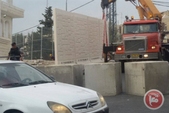
Israeli forces shot and injured a Palestinian man near the Gazan border Wednesday morning after they said he crossed the border into Israel. An Israeli army spokeswoman said that soldiers went to the scene after they "identified a suspect infiltrating Israel from the sea."
She could not confirm how he crossed the border, but said he reached the Israeli side. She said that soldiers fired warning shots and ordered him to halt. When he "did not comply," she said that they fired "at his lower extremities" and a hit was confirmed.
She said the Palestinian "was evacuated for medical treatment in an Israeli hospital." Sources at Barzilai Medical Center in Ashkelon told Ma'an that the Gazan had been brought to them. They said he had been hit in the leg and was in a stable condition.
Israeli news site Walla reported that he was shot while approaching a border sea fence off the coast of northern Gaza, although this could not be confirmed. Israeli forces have repeatedly opened fire on Palestinian fisherman and farmers since the ceasefire agreement signed Aug. 26, 2014 that ended a devastating 50-day Israeli military offensive against the Gaza Strip.
In July alone, the Palestinian Center for Human Rights counted 27 incidents of shootings, incursions into the territory, and arrests. This included 18 shootings on land and at sea that left nine Palestinians injured, PCHR reported.
The attacks come despite Israeli promises at the end of the ceasefire to ease restrictions on Palestinian access to both the sea and the border region near the "security buffer zone."
She could not confirm how he crossed the border, but said he reached the Israeli side. She said that soldiers fired warning shots and ordered him to halt. When he "did not comply," she said that they fired "at his lower extremities" and a hit was confirmed.
She said the Palestinian "was evacuated for medical treatment in an Israeli hospital." Sources at Barzilai Medical Center in Ashkelon told Ma'an that the Gazan had been brought to them. They said he had been hit in the leg and was in a stable condition.
Israeli news site Walla reported that he was shot while approaching a border sea fence off the coast of northern Gaza, although this could not be confirmed. Israeli forces have repeatedly opened fire on Palestinian fisherman and farmers since the ceasefire agreement signed Aug. 26, 2014 that ended a devastating 50-day Israeli military offensive against the Gaza Strip.
In July alone, the Palestinian Center for Human Rights counted 27 incidents of shootings, incursions into the territory, and arrests. This included 18 shootings on land and at sea that left nine Palestinians injured, PCHR reported.
The attacks come despite Israeli promises at the end of the ceasefire to ease restrictions on Palestinian access to both the sea and the border region near the "security buffer zone."
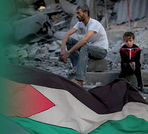
UNCTAD says 'social, health and security-related ramifications of the high population density and overcrowding,' as well as dire economic situation in the blockaded enclave could render it unlivable in just five more years.
The Gaza Strip, ravaged by wars and nearly a decade of a gruelling Israeli blockade, could become uninhabitable for residents within just five years, the United Nations development agency said Tuesday.
"The social, health and security-related ramifications of the high population density and overcrowding are among the factors that may render Gaza unliveable by 2020," the UN Conference on Trade and Development (UNCTAD) wrote in its annual report. Gaza, a tiny enclave of just 362 square kilometres (about 225 square miles) squeezed between Israel, Egypt and the Mediterranean Sea, that is home to some 1.8 million Palestinians, counts one of the highest population densities in the world. "Gaza could become uninhabitable by 2020 if current economic trends persist," the report said.
While the high density is not new, the situation has been exacerbated by three Israeli military operations in the past six years and nearly a decade-long economic blockade. The blockade had "ravaged the already debilitated infrastructure of Gaza, shattered its productive base, left no time for meaningful reconstruction or economic recovery and impoverished the Palestinian population in Gaza," the report said.
"Short of ending the blockade, donor aid... will not reverse the ongoing de-development and impoverishment in Gaza," it said.
Socio-economic conditions in Gaza today are currently "at their lowest point since 1967," when Israel seized the territory from Egypt in its Six-Day War, according to the report.
The report estimated that the three military operations, including last year's devastating war that killed some 2,200 Palestinians and displaced half a million more, had caused economic losses close to three times the size of Gaza's local gross domestic product.
The 2014 war, which also left 73 Israelis dead, destroyed or severely damaged more than 20,000 Palestinian homes, 148 schools, 15 hospitals and 45 primary healthcare centres, UNCTAD said.
As many as 247 factories and 300 commercial centres were fully or partially destroyed, and Gaza's only power station sustained severe damage, it said.
Water crisis, record unemployment
Even before last year's conflict, Gaza's electricity supply was not even enough to cover 40 percent of demand, UNCTAD said, adding that 95 percent of water from coastal aquifers - Gazans main source of freshwater - was considered unsafe to drink.
Unemployment in Gaza meanwhile soared last year to 44 percent - the highest level on record - hitting young women especially hard, leaving more than eight out of 10 women out of work.
A full 72 percent of all households in Gaza are meanwhile struggling with food insecurity, and the number of Palestinian refugees who rely entirely on food distribution from UN agency has ballooned from 72,000 in 2000 to 868,000 by last May.
The report also detailed the devastating effect of the blockade imposed by Israel after Hamas militants captured an Israeli soldier in the summer of 2006 and tightened a year later after the Islamists forcibly ousted troops loyal to Palestinian president Mahmoud Abbas's Fatah.
"It inflicted large-scale destruction on Gaza's local economy, productive assets and infrastructure, and affected numerous industrial, agricultural, commercial and residential facilities either directly or indirectly through debilitated infrastructure and acute shortages of inputs, water, electricity and fuel," it said.
Exports had basically been completely banned, as imports of anything besides the most basic humanitarian goods had been blocked.
The dire situation has left Gaza relying heavily on aid, but the report warned that while donor support would remain vital, it could not turn around the situation in the Strip alone.
Gaza Could Be Uninhabitable In 5 Years, UN Report Warns
A new report by the UN Conference on Trade and Development (UNCTAD) found that under current conditions, the Gaza Strip, home to 1.8 million Palestinians, will become uninhabitable within the next five years.
The report states that "The social, health and security-related ramifications of the high population density and overcrowding are among the factors that may render Gaza unliveable by 2020".
The UNCTAD report, entitled "Assistance to the Palestinian people: Developments in the economy of the Occupied Palestinian Territory", was released today.
The report examined the current conditions in the coastal strip, and found that Gaza could become uninhabitable by 2020 due to ongoing de-development, eight years of economic blockade and three military operations in the past six years.
Last year's invasion by the Israeli military "ravaged the already debilitated infrastructure of Gaza, shattered its productive base, left no time for meaningful reconstruction or economic recovery and impoverished the Palestinian population in Gaza," the report said.
The report also called for an end to the Israeli siege on Gaza, stating, "Short of ending the blockade, donor aid... will not reverse the ongoing de-development and impoverishment in Gaza."
According to the UN Report, socio-economic conditions in Gaza today are currently "at their lowest point since 1967,"
In addition to the 500,000 people who have been displaced in Gaza as a result of the most recent military operation in 2014, the report estimates significant economic losses, including the destruction or severe damage of more than 20,000 Palestinian homes, 148 schools and 15 hospitals and 45 primary health-care centres.
For the full report, click on the link
The Gaza Strip, ravaged by wars and nearly a decade of a gruelling Israeli blockade, could become uninhabitable for residents within just five years, the United Nations development agency said Tuesday.
"The social, health and security-related ramifications of the high population density and overcrowding are among the factors that may render Gaza unliveable by 2020," the UN Conference on Trade and Development (UNCTAD) wrote in its annual report. Gaza, a tiny enclave of just 362 square kilometres (about 225 square miles) squeezed between Israel, Egypt and the Mediterranean Sea, that is home to some 1.8 million Palestinians, counts one of the highest population densities in the world. "Gaza could become uninhabitable by 2020 if current economic trends persist," the report said.
While the high density is not new, the situation has been exacerbated by three Israeli military operations in the past six years and nearly a decade-long economic blockade. The blockade had "ravaged the already debilitated infrastructure of Gaza, shattered its productive base, left no time for meaningful reconstruction or economic recovery and impoverished the Palestinian population in Gaza," the report said.
"Short of ending the blockade, donor aid... will not reverse the ongoing de-development and impoverishment in Gaza," it said.
Socio-economic conditions in Gaza today are currently "at their lowest point since 1967," when Israel seized the territory from Egypt in its Six-Day War, according to the report.
The report estimated that the three military operations, including last year's devastating war that killed some 2,200 Palestinians and displaced half a million more, had caused economic losses close to three times the size of Gaza's local gross domestic product.
The 2014 war, which also left 73 Israelis dead, destroyed or severely damaged more than 20,000 Palestinian homes, 148 schools, 15 hospitals and 45 primary healthcare centres, UNCTAD said.
As many as 247 factories and 300 commercial centres were fully or partially destroyed, and Gaza's only power station sustained severe damage, it said.
Water crisis, record unemployment
Even before last year's conflict, Gaza's electricity supply was not even enough to cover 40 percent of demand, UNCTAD said, adding that 95 percent of water from coastal aquifers - Gazans main source of freshwater - was considered unsafe to drink.
Unemployment in Gaza meanwhile soared last year to 44 percent - the highest level on record - hitting young women especially hard, leaving more than eight out of 10 women out of work.
A full 72 percent of all households in Gaza are meanwhile struggling with food insecurity, and the number of Palestinian refugees who rely entirely on food distribution from UN agency has ballooned from 72,000 in 2000 to 868,000 by last May.
The report also detailed the devastating effect of the blockade imposed by Israel after Hamas militants captured an Israeli soldier in the summer of 2006 and tightened a year later after the Islamists forcibly ousted troops loyal to Palestinian president Mahmoud Abbas's Fatah.
"It inflicted large-scale destruction on Gaza's local economy, productive assets and infrastructure, and affected numerous industrial, agricultural, commercial and residential facilities either directly or indirectly through debilitated infrastructure and acute shortages of inputs, water, electricity and fuel," it said.
Exports had basically been completely banned, as imports of anything besides the most basic humanitarian goods had been blocked.
The dire situation has left Gaza relying heavily on aid, but the report warned that while donor support would remain vital, it could not turn around the situation in the Strip alone.
Gaza Could Be Uninhabitable In 5 Years, UN Report Warns
A new report by the UN Conference on Trade and Development (UNCTAD) found that under current conditions, the Gaza Strip, home to 1.8 million Palestinians, will become uninhabitable within the next five years.
The report states that "The social, health and security-related ramifications of the high population density and overcrowding are among the factors that may render Gaza unliveable by 2020".
The UNCTAD report, entitled "Assistance to the Palestinian people: Developments in the economy of the Occupied Palestinian Territory", was released today.
The report examined the current conditions in the coastal strip, and found that Gaza could become uninhabitable by 2020 due to ongoing de-development, eight years of economic blockade and three military operations in the past six years.
Last year's invasion by the Israeli military "ravaged the already debilitated infrastructure of Gaza, shattered its productive base, left no time for meaningful reconstruction or economic recovery and impoverished the Palestinian population in Gaza," the report said.
The report also called for an end to the Israeli siege on Gaza, stating, "Short of ending the blockade, donor aid... will not reverse the ongoing de-development and impoverishment in Gaza."
According to the UN Report, socio-economic conditions in Gaza today are currently "at their lowest point since 1967,"
In addition to the 500,000 people who have been displaced in Gaza as a result of the most recent military operation in 2014, the report estimates significant economic losses, including the destruction or severe damage of more than 20,000 Palestinian homes, 148 schools and 15 hospitals and 45 primary health-care centres.
For the full report, click on the link
1 sept 2015
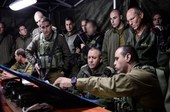
Al-Jazeera satellite channel intends to broadcast a new documentary film next Thursday lifting the curtain on Israel's military plans and moves before and during its 2014 offensive against the Gaza Strip.
The documentary will turn the spotlight on how the Israeli army and its intelligence agencies had dealt with and reacted to the Palestinian resistance's special operations during the war.
It will include confessions and testimonies made for the first time by high-ranking military and intelligence leaders as well as soldiers and officers who took part in the aggression against Gaza.
The documentary will turn the spotlight on how the Israeli army and its intelligence agencies had dealt with and reacted to the Palestinian resistance's special operations during the war.
It will include confessions and testimonies made for the first time by high-ranking military and intelligence leaders as well as soldiers and officers who took part in the aggression against Gaza.
31 aug 2015
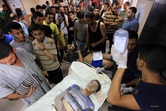
File photo of patients rushed to Al-Shifa hospital during last Summer's Israeli offensive on Gaza. It's reported that Israeli soldiers will occupy the hospital during future engagements in order to prevent the broadcast of images of civilian casualties
There is a shortage of intelligence about the Gaza Strip, the Israel Defence Forces have claimed. The shortage, Felesteen reported on Sunday, affects the IDF’s ability to carry out Special Forces operations. The newspaper quoted Israel’s Walla website, which is close to the Israeli intelligence agencies, as saying that senior Israeli military sources believe that the disengagement with the Gaza Strip in August 2005 diminished their abilities to recruit spies in Gaza. Such difficulties were made obvious by the Gilad Shalit affair, said Walla. During the five years of his captivity, the IDF had no intelligence about his whereabouts, even though the Gaza Strip is a relatively small territory.
Online newspaper Today’s Opinion claimed that the lack of information about Shalit proved the failure of Israeli intelligence. It added that a lack of information undermines Israel’s ability to carry out operations in Syria and Lebanon.
Today’s Opinion also said that Israeli naval commandos attempted to carry out a surprise attack against Hamas in the north of the Gaza Strip during last year’s summer offensive. Their failure resulting from Hamas vigilance was considered to be a “resounding failure” by Israel. Indeed, former Chief of Staff Beni Gantz has hinted that carrying out special operations in the heart of Gaza is “impossible” due to Hamas preparations.
Meanwhile, an Israeli military official has said that Israeli will occupy Al-Shifa Hospital in Gaza City during any future war. The official claimed that the hospital would be under Hamas control and the movement’s command headquarters. The purpose, reported Walla, would be to prevent the broadcast of images of the inevitable civilian casualties and thus reduce the damage to Israel’s reputation in the international arena.
Israel’s strategy in a future war against the people of Gaza, it has been reported recently, will include massive attacks in an attempt to shorten the conflict.
There is a shortage of intelligence about the Gaza Strip, the Israel Defence Forces have claimed. The shortage, Felesteen reported on Sunday, affects the IDF’s ability to carry out Special Forces operations. The newspaper quoted Israel’s Walla website, which is close to the Israeli intelligence agencies, as saying that senior Israeli military sources believe that the disengagement with the Gaza Strip in August 2005 diminished their abilities to recruit spies in Gaza. Such difficulties were made obvious by the Gilad Shalit affair, said Walla. During the five years of his captivity, the IDF had no intelligence about his whereabouts, even though the Gaza Strip is a relatively small territory.
Online newspaper Today’s Opinion claimed that the lack of information about Shalit proved the failure of Israeli intelligence. It added that a lack of information undermines Israel’s ability to carry out operations in Syria and Lebanon.
Today’s Opinion also said that Israeli naval commandos attempted to carry out a surprise attack against Hamas in the north of the Gaza Strip during last year’s summer offensive. Their failure resulting from Hamas vigilance was considered to be a “resounding failure” by Israel. Indeed, former Chief of Staff Beni Gantz has hinted that carrying out special operations in the heart of Gaza is “impossible” due to Hamas preparations.
Meanwhile, an Israeli military official has said that Israeli will occupy Al-Shifa Hospital in Gaza City during any future war. The official claimed that the hospital would be under Hamas control and the movement’s command headquarters. The purpose, reported Walla, would be to prevent the broadcast of images of the inevitable civilian casualties and thus reduce the damage to Israel’s reputation in the international arena.
Israel’s strategy in a future war against the people of Gaza, it has been reported recently, will include massive attacks in an attempt to shorten the conflict.

The Israeli Occupation Forces (IOF) opened their machine gun fire Monday morning towards Palestinian fishermen and farmers in Gaza Strip. No injuries were reported during the attack.
Eyewitnesses said that Israeli soldiers stationed at military watchtowers east of Khan Younis opened heavy fire at Palestinian farmers and Palestinian homes in the border area.
The attack coincided with intensive flights of Israeli drones over the area, the sources added.
In a similar attack, Israeli Navy Forces attacked Palestinian fishing boats Monday morning while sailing within the Israeli-imposed six-nautical-miles fishing zone off Gaza City on Saturday morning.
Palestinian sources said no injuries were reported during the attack. However, the fishermen were forced to leave the sea.
Israeli forces routinely open fire at Palestinian fishermen and farmers in flagrant violation of the calm agreement reached on August 26, 2014 to end Israel’s summer aggression on Gaza that claimed the lives of over 2,200 people, mostly children and women.
Eyewitnesses said that Israeli soldiers stationed at military watchtowers east of Khan Younis opened heavy fire at Palestinian farmers and Palestinian homes in the border area.
The attack coincided with intensive flights of Israeli drones over the area, the sources added.
In a similar attack, Israeli Navy Forces attacked Palestinian fishing boats Monday morning while sailing within the Israeli-imposed six-nautical-miles fishing zone off Gaza City on Saturday morning.
Palestinian sources said no injuries were reported during the attack. However, the fishermen were forced to leave the sea.
Israeli forces routinely open fire at Palestinian fishermen and farmers in flagrant violation of the calm agreement reached on August 26, 2014 to end Israel’s summer aggression on Gaza that claimed the lives of over 2,200 people, mostly children and women.
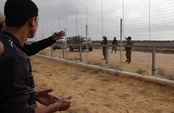
Israeli soldiers, stationed across the border fence, opened fire on Monday morning at a number of Palestinian farmers, in their lands, and at several homes, east of Khan Younis in the southern part of the Gaza Strip.
The WAFA News Agency has reported that the soldiers fired dozens of rounds of live ammunition targeting farmers and homes, east of Khuza’a border town, causing anxiety attack among several children.
The Palestinians had to leave their lands, and try to seek shelter in their homes that also came under Israeli army fire.
The soldiers frequently attack Palestinian homes and lands in border areas in the Gaza Strip, in addition to ongoing assaults and violations targeting Gaza fishers and their boats.
The WAFA News Agency has reported that the soldiers fired dozens of rounds of live ammunition targeting farmers and homes, east of Khuza’a border town, causing anxiety attack among several children.
The Palestinians had to leave their lands, and try to seek shelter in their homes that also came under Israeli army fire.
The soldiers frequently attack Palestinian homes and lands in border areas in the Gaza Strip, in addition to ongoing assaults and violations targeting Gaza fishers and their boats.
30 aug 2015

The Israeli occupation navy at dawn Sunday opened machinegun fire at Palestinian fishing boats off the northwestern coast of the besieged Gaza Strip, with no reported causalities.
Eyewitnesses reported that Israeli frigates attacked the fishermen off the coast of al-Waha and al-Sudaniya areas and chased a number of them, which forced all boats to go back to the shores.
The Israeli army had unilaterally reduced the fishing limit off the coast of Gaza to three nautical miles from the six miles agreed on as part of the last ceasefire agreement.
Eyewitnesses reported that Israeli frigates attacked the fishermen off the coast of al-Waha and al-Sudaniya areas and chased a number of them, which forced all boats to go back to the shores.
The Israeli army had unilaterally reduced the fishing limit off the coast of Gaza to three nautical miles from the six miles agreed on as part of the last ceasefire agreement.
29 aug 2015
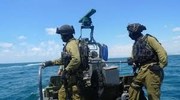
Israeli naval boats opened machine gunfire on Palestinian fishing boats while sailing within the Israeli-imposed six-nautical-miles fishing zone offshore Gaza City on Saturday morning.
Palestinian sources said that no injuries were reported during the armed attack. However, the fishermen were forced to leave the sea.
Israeli naval boats routinely open fire at Palestinian fishermen sailing within the six-nautical-miles zone in flagrant violation of the calm agreement.
Israel and the Palestinian resistance reached a calm agreement on August 26, 2014 ending Israel’s summer aggression on Gaza that claimed the lives of over 2,200 people, mostly children and women.
Palestinian sources said that no injuries were reported during the armed attack. However, the fishermen were forced to leave the sea.
Israeli naval boats routinely open fire at Palestinian fishermen sailing within the six-nautical-miles zone in flagrant violation of the calm agreement.
Israel and the Palestinian resistance reached a calm agreement on August 26, 2014 ending Israel’s summer aggression on Gaza that claimed the lives of over 2,200 people, mostly children and women.
27 aug 2015

Rockets being fired at Israel from the Gaza Strip during Operation Protective Edge in 2014
No injuries or damage reported in rocket fire on Eshkol Regional Council; IAF strikes Hamas weapons facility in central Gaza Strip.
Israeli aircraft targeted a weapons manufacturing facility in central Gaza Strip early Thursday morning in reaction to a rocket that was fired from the Palestinian enclave and landed in an open area in the Eshkol Regional Council earlier in the night.
No injuries or damage was reported in the rocket fire and the results of Israel's retaliation were unclear. The IDF said that the targeted facility belonged to Hamas, the extremist Palestinian faction currently in control of the Strip.
The IDF also confirmed the rocket attack, adding that one projectile had landed near the border fence and that code red sirens meant to alert residents of incoming rocket fire were not triggered.
According to the IDF, code red sirens failed to sound because the rocket did not pose a threat to inhabited areas.
Residents reported hearing an explosion from the rocket just after midnight. Security forces spent the night searching the field for the projectile.
The last incident of rocket fire from Gaza occurred three weeks ago on August 7 when code red sirens also remained silent and one projectile landed inside Israel with another falling short, landing in Gaza.
Israeli aircraft also retaliated to this incident, attacking the Gaza Strip and wounding two Hamas militants, according to the organization.
No injuries or damage reported in rocket fire on Eshkol Regional Council; IAF strikes Hamas weapons facility in central Gaza Strip.
Israeli aircraft targeted a weapons manufacturing facility in central Gaza Strip early Thursday morning in reaction to a rocket that was fired from the Palestinian enclave and landed in an open area in the Eshkol Regional Council earlier in the night.
No injuries or damage was reported in the rocket fire and the results of Israel's retaliation were unclear. The IDF said that the targeted facility belonged to Hamas, the extremist Palestinian faction currently in control of the Strip.
The IDF also confirmed the rocket attack, adding that one projectile had landed near the border fence and that code red sirens meant to alert residents of incoming rocket fire were not triggered.
According to the IDF, code red sirens failed to sound because the rocket did not pose a threat to inhabited areas.
Residents reported hearing an explosion from the rocket just after midnight. Security forces spent the night searching the field for the projectile.
The last incident of rocket fire from Gaza occurred three weeks ago on August 7 when code red sirens also remained silent and one projectile landed inside Israel with another falling short, landing in Gaza.
Israeli aircraft also retaliated to this incident, attacking the Gaza Strip and wounding two Hamas militants, according to the organization.
26 aug 2015
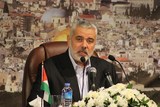
Deputy head of Hamas’ political bureau Ismail Haniyeh revealed Tuesday evening that the Israeli occupation was not responsible for the injury of the leader Imad al-Alami during the last war on Gaza.
During a conference to present Dr. Mahmoud al-Zahar’s novel “the eaten straw”, Haniyeh said that the Israeli enemy has no relation with the accident that he was subjected to along with al-Alami during the Israeli summer aggression.
Al-Alami was transferred to Turkey for treatment as he was injured during the last aggression on Gaza.
The next battle would be the liberation battle, Haniyeh said, pointing out that Israel was the one who starts the war on Gaza.
Palestinian resistance topped by al-Qassam Brigades is today stronger than before, he continued.
Haniyeh stressed that the security coordination policy would not succeed to stop resistance in West Bank.
During the conference, Haniyeh stressed the importance of al-Zahar’s novel as it narrates real and heroic stories made by Palestinian people and resistance during Israel’s summer aggression.
During a conference to present Dr. Mahmoud al-Zahar’s novel “the eaten straw”, Haniyeh said that the Israeli enemy has no relation with the accident that he was subjected to along with al-Alami during the Israeli summer aggression.
Al-Alami was transferred to Turkey for treatment as he was injured during the last aggression on Gaza.
The next battle would be the liberation battle, Haniyeh said, pointing out that Israel was the one who starts the war on Gaza.
Palestinian resistance topped by al-Qassam Brigades is today stronger than before, he continued.
Haniyeh stressed that the security coordination policy would not succeed to stop resistance in West Bank.
During the conference, Haniyeh stressed the importance of al-Zahar’s novel as it narrates real and heroic stories made by Palestinian people and resistance during Israel’s summer aggression.
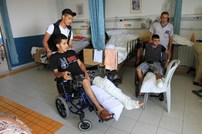
Defense for Children International - Palestine (DCIP) revealed on Tuesday that over 1,000 children suffered, as a result of Israel's last summer’s aggression on Gaza, injuries that rendered them permanently disabled, according to OCHA.
The Israeli aggression, which lasted 51 days, claimed the lives of 2,220 Palestinians, including at least 1,492 civilians. 3,374 others were injured including 1,000 children who suffered disabilities, according to the United Nations Office for the Coordination of Humanitarian Affairs (OCHA).
DCIP independently verified the deaths of 547 Palestinian children among the killed in Gaza, 535 of them as a direct result of Israeli attacks. Nearly 68 percent of the children killed by Israeli forces were 12 years old or younger.
Evidence and testimonies collected by DCIP showed that there was no safe place for children in Gaza during the Israeli assault. Children were killed in their homes by Israeli missiles, while sheltering in schools by high-explosive Israeli artillery shells, and in the streets by Israeli drone-fired missiles and artillery shells as they attempted to escape the onslaught with their families.
Among those cases was a child from Rafah called Ibrahim Abu Shabab, in the sixth grade. He was wounded by shrapnel in his neck and suffered a fracture in the right thigh bone and shrapnel in other parts of the body leaving him in a very critical situation.
His mother said he underwent several surgeries and was absent of his school for three months which affected his educational progress.
Another child named Bilal al-Sherafi, 11, from Gaza city, was injured by shrapnel all over his body due to Israeli missiles. His mother and brother were killed in the Israeli missile attack.
He stayed for a month at hospital because of the seriousness of his condition at the time, then, was transferred alone to be treated in Germany. He spent 10 months there and lost the opportunity to register in the school year of the fifth grade.
A third child, called Thaer Jodeh, 10, from Jabalya, lost his right leg and was injured with shrapnel in his body and suffered laceration to his hands because of Israeli missiles which killed his mother and four of his siblings.
He was also taken to Germany for treatment and spent ten months there. He was given an artificial limb that needs to be changed as the child is growing up.
The Israeli aggression, which lasted 51 days, claimed the lives of 2,220 Palestinians, including at least 1,492 civilians. 3,374 others were injured including 1,000 children who suffered disabilities, according to the United Nations Office for the Coordination of Humanitarian Affairs (OCHA).
DCIP independently verified the deaths of 547 Palestinian children among the killed in Gaza, 535 of them as a direct result of Israeli attacks. Nearly 68 percent of the children killed by Israeli forces were 12 years old or younger.
Evidence and testimonies collected by DCIP showed that there was no safe place for children in Gaza during the Israeli assault. Children were killed in their homes by Israeli missiles, while sheltering in schools by high-explosive Israeli artillery shells, and in the streets by Israeli drone-fired missiles and artillery shells as they attempted to escape the onslaught with their families.
Among those cases was a child from Rafah called Ibrahim Abu Shabab, in the sixth grade. He was wounded by shrapnel in his neck and suffered a fracture in the right thigh bone and shrapnel in other parts of the body leaving him in a very critical situation.
His mother said he underwent several surgeries and was absent of his school for three months which affected his educational progress.
Another child named Bilal al-Sherafi, 11, from Gaza city, was injured by shrapnel all over his body due to Israeli missiles. His mother and brother were killed in the Israeli missile attack.
He stayed for a month at hospital because of the seriousness of his condition at the time, then, was transferred alone to be treated in Germany. He spent 10 months there and lost the opportunity to register in the school year of the fifth grade.
A third child, called Thaer Jodeh, 10, from Jabalya, lost his right leg and was injured with shrapnel in his body and suffered laceration to his hands because of Israeli missiles which killed his mother and four of his siblings.
He was also taken to Germany for treatment and spent ten months there. He was given an artificial limb that needs to be changed as the child is growing up.
25 aug 2015
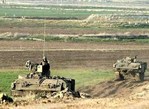
The Israeli occupation forces (IOF) at dawn Tuesday rolled into the northern area of the blockaded Gaza Strip, leveled Palestinian cultivated lands, and attacked Palestinian farmers and homes with random spates of gunfire.
A number of Israeli army bulldozers and tanks moved some 100 meters into the northeastern corners of Beit Hanoun, to the north of Gaza, and razed Palestinian cultivated land lots without prior notices, an on-the-spot observer told the Quds Press.
The invading IOF troops targeted the Palestinian farmers and civilian homes with randomly-shot barrages of gunfire, the same source added.
The incursion is another chain in the series of Israeli violations of the Cairo-brokered ceasefire accord signed with Palestinian resistance factions in the wake of last summer’s Israeli offensive on Gaza.
An Israeli 51-day military aggression on the besieged coastal enclave last summer took away the lives of over 2,200 Palestinians, mostly civilian children and women, and left thousands of others critically wounded.
A number of Israeli army bulldozers and tanks moved some 100 meters into the northeastern corners of Beit Hanoun, to the north of Gaza, and razed Palestinian cultivated land lots without prior notices, an on-the-spot observer told the Quds Press.
The invading IOF troops targeted the Palestinian farmers and civilian homes with randomly-shot barrages of gunfire, the same source added.
The incursion is another chain in the series of Israeli violations of the Cairo-brokered ceasefire accord signed with Palestinian resistance factions in the wake of last summer’s Israeli offensive on Gaza.
An Israeli 51-day military aggression on the besieged coastal enclave last summer took away the lives of over 2,200 Palestinians, mostly civilian children and women, and left thousands of others critically wounded.
20 aug 2015
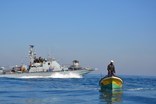
Israeli military patrols advanced Thursday morning into the northern border areas of Gaza Strip, while Israeli Navy Forces opened fire at Palestinian fishermen off Gaza northern shores.
Eyewitnesses said that a number of Israeli military vehicles and bulldozers moved into Beit Hanoun town to the north of Gaza Strip this morning.
The invading troops opened their machine gun fire at Palestinian farmers near the border areas amid sustained flights of Israeli drones over the area.
Meanwhile, Israeli Navy boats opened heavy fire at Palestinian fishing boats off Gaza northern shores.
Palestinian fishermen were forced to leave the sea, while no injuries were reported.
Israeli Tanks Conduct Limited Invasion into Northern Gaza
Eyewitnesses from Beit Hanoun city, northern Gaza Strip, on Wednesday, said that four Israeli tanks and three bulldozers entered the Strip, opened fire and razed civilian lands.
Locals said that the vehicles entered more than 150 meters into the strip, and razed private lands, according to the PNN.
In the center of the Strip, Israeli soldiers in military watchtowers opened fire on farmlands, and a monitoring plane was seen to be roaming in the Beit Hanoun sky.
Israeli tanks and bulldozers often enter the Gaza strip, violating the truce signed last August between Gaza ruling (Hamas) and Israel, following the 51-day aggression that killed over 2,200 Palestinians.
In addition to the invasions, Israeli soldiers open fire on civilian homes, target farmers and fishermen, especially near the Gaza borders.
Eyewitnesses said that a number of Israeli military vehicles and bulldozers moved into Beit Hanoun town to the north of Gaza Strip this morning.
The invading troops opened their machine gun fire at Palestinian farmers near the border areas amid sustained flights of Israeli drones over the area.
Meanwhile, Israeli Navy boats opened heavy fire at Palestinian fishing boats off Gaza northern shores.
Palestinian fishermen were forced to leave the sea, while no injuries were reported.
Israeli Tanks Conduct Limited Invasion into Northern Gaza
Eyewitnesses from Beit Hanoun city, northern Gaza Strip, on Wednesday, said that four Israeli tanks and three bulldozers entered the Strip, opened fire and razed civilian lands.
Locals said that the vehicles entered more than 150 meters into the strip, and razed private lands, according to the PNN.
In the center of the Strip, Israeli soldiers in military watchtowers opened fire on farmlands, and a monitoring plane was seen to be roaming in the Beit Hanoun sky.
Israeli tanks and bulldozers often enter the Gaza strip, violating the truce signed last August between Gaza ruling (Hamas) and Israel, following the 51-day aggression that killed over 2,200 Palestinians.
In addition to the invasions, Israeli soldiers open fire on civilian homes, target farmers and fishermen, especially near the Gaza borders.
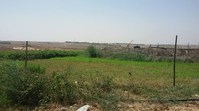
Juhr al-Deek village, which is the only landfill in the Gaza Strip, is also a very fertile agricultural land.
The village, its farms, homes, and all properties are being bulldozed and razed by the Israeli Occupation Forces (IOF) on daily basis. The village's residents have become accustomed to these continued violations.
Mayor of Wadi Gaza, Salem Abu Ayada, affirmed in an exclusive interview with the PIC that 580 homes were razed to the ground during the notorious Israeli aggression in summer 2014, more than 300 were partially damaged, and most houses in the village were destroyed at different levels.
"Regardless of peacetime or wartime, agricultural lands in the village are always bulldozed by IOF; as the village is close to the 1948 occupied lands," the mayor charged.
Juhr al-Deek village is 8 kilometers to the south of Gaza City and it is bounded on the east by the 1948 occupied lands, on the west by Salah al-Deen Street, on the north by Mintar (Karni) crossing, and on the south by Wadi Gaza.
The village's residents lead miserable lives due to the lack of essential services; the village only contains one girls' school for all educational levels and one health center while the urban area is 100 acres. They live in caravans and tents and suffer from the scorching temperature, Abu Ayada said.
Gaza's food basket
Abu Ayada pointed out that Juhr al-Deek village provides its residents in particular and Gaza's residents in general with a huge amount of the agricultural products they need.
Abu Ayada said that the government must adopt policies that support the citizens and the farmers residing in border areas; so as to provide them with ways of making a decent living which will positively affect all the inhabitants of the besieged enclave.
He urged all officials, the media, and the concerned institutions to help the civilians and reconstruct the destroyed homes and farms which constitute Gaza's lifeline.
"The village and its farmers are totally ignored and marginalized," Nabil Shamaly, a farmer from Juhr al-Deek said, explaining that after the last Israeli aggression on Gaza all the ministries have compensated the affected people except for the Ministry of Agriculture.
"Our farms used to contain twice as much as they do today, we used to have more than 50-60 thousand chickens but today the number has shrunk by half because the IOF destroyed large areas of these farms," Nabil regretted.
The village, its farms, homes, and all properties are being bulldozed and razed by the Israeli Occupation Forces (IOF) on daily basis. The village's residents have become accustomed to these continued violations.
Mayor of Wadi Gaza, Salem Abu Ayada, affirmed in an exclusive interview with the PIC that 580 homes were razed to the ground during the notorious Israeli aggression in summer 2014, more than 300 were partially damaged, and most houses in the village were destroyed at different levels.
"Regardless of peacetime or wartime, agricultural lands in the village are always bulldozed by IOF; as the village is close to the 1948 occupied lands," the mayor charged.
Juhr al-Deek village is 8 kilometers to the south of Gaza City and it is bounded on the east by the 1948 occupied lands, on the west by Salah al-Deen Street, on the north by Mintar (Karni) crossing, and on the south by Wadi Gaza.
The village's residents lead miserable lives due to the lack of essential services; the village only contains one girls' school for all educational levels and one health center while the urban area is 100 acres. They live in caravans and tents and suffer from the scorching temperature, Abu Ayada said.
Gaza's food basket
Abu Ayada pointed out that Juhr al-Deek village provides its residents in particular and Gaza's residents in general with a huge amount of the agricultural products they need.
Abu Ayada said that the government must adopt policies that support the citizens and the farmers residing in border areas; so as to provide them with ways of making a decent living which will positively affect all the inhabitants of the besieged enclave.
He urged all officials, the media, and the concerned institutions to help the civilians and reconstruct the destroyed homes and farms which constitute Gaza's lifeline.
"The village and its farmers are totally ignored and marginalized," Nabil Shamaly, a farmer from Juhr al-Deek said, explaining that after the last Israeli aggression on Gaza all the ministries have compensated the affected people except for the Ministry of Agriculture.
"Our farms used to contain twice as much as they do today, we used to have more than 50-60 thousand chickens but today the number has shrunk by half because the IOF destroyed large areas of these farms," Nabil regretted.
Truce violations List of names Pictures of martyrs
Days: Aug: 26 - 25 - 24 - 23 - 22 - 21 - 20 - 19 - 18 - 17 - 16 - 15 - 14 - 13 - 12 - 11 - 10 - 9 - 8 - 7 - 6 - 5 - 4 - 3 - 2 - 1
July: 31 - 30 - 29 - 28 - 27 - 26 - 25 - 24 - 23 - 22 - 21 - 20 - 19 - 18 - 17 - 16 - 15 - 14 - 13 - 12 - 11 - 10 - 9 - 8
